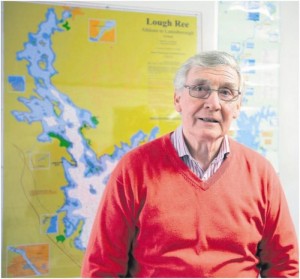The Athlone branch IWAI nominated Damien for the people of the year awards in recognition of all his voluntary work with the waterways through the years. The branch celebrated his win at a gala dinner in the Radisson hotel in April.
There’s one common thread that binds Damien Delaney’s various voluntary and leisure pursuits together: the waterways. The current volunteer manager of the Royal National Lifeboats Institution (RNLI) lifeboat station in Athlone was first introduced to what would be his life’s passion when he moved to Coosan, Athlone, in the 1960s, following his marriage to Bridie.
 When he retired from Eircom in 2004 after 43 years’ service, you would imagine Damien would have been at liberty to indulge his enthusiasm for the inland waterways of Ireland. But as volunteer manager of the fledgling RNLI station at Coosan Point in Athlone, Damien’s free time is limited. It is his responsibility to oversee the smooth running of the key search and rescue service which covers all of Lough Ree. The RNLI lifeboat station went live in July 2012, after years of campaigning and lobbying to have such a formal search and rescue service in place on Lough Ree.
When he retired from Eircom in 2004 after 43 years’ service, you would imagine Damien would have been at liberty to indulge his enthusiasm for the inland waterways of Ireland. But as volunteer manager of the fledgling RNLI station at Coosan Point in Athlone, Damien’s free time is limited. It is his responsibility to oversee the smooth running of the key search and rescue service which covers all of Lough Ree. The RNLI lifeboat station went live in July 2012, after years of campaigning and lobbying to have such a formal search and rescue service in place on Lough Ree.
For many years, there had been a local branch of the RNLI in Athlone and funds were regularly raised at annual flag days. After the introduction of an RNLI lifeboat service on Lough Derg and Lough Erne in recent years, local enthusiasts, led by the Inland Waterways Association of Ireland (IWAI), engaged in extensive discussions with the RNLI. Under the chairmanship of Dave McCabe, the local IWAI branch joined forces with the RNLI to refine proposals for such a service on Lough Ree. A sub-committee, including McCabe, Delaney, Vincent Rafter, Brian Corcoran and Denis Bergin was established.
Public meetings to gauge the interest in establishing the service in the region were held and the sub-committee prepared a case for the RNLI headquarters in Poole in England. Having got the go-ahead, an operational team was set up in November 2011, training for volunteers began in March 2012 and the service was up and running four months later. By the end of 2012, after the first nine months of its existence, it launched 14 rescue efforts in and brought a total of 18 people to safety.
Although these figures indicate the importance of the service, an RNLI lifeboat station does not simply develop without remarkable dedication and commitment from a wide range of volunteers. The service currently has a 26-strong group, including boat crew, land crew and operation managers. All need to live within a close radius of the base at Coosan Point as the lifeboat must be launched within ten minutes of receipt of a call. And all must have the flexibility, and the approval of their employers, to respond when required.
The procedure is simple. Emergency calls are made to the Malin Coastguard either via on-ship VHF radio or through the standard 999 emergency service. The Coastguard contacts the RNLI Lifeboat station in Athlone and, if conditions permit, the RNLI service summons its volunteers via a paging system. At present there are some 18 volunteer crew members. Three are required for each mission, one as helm and two as crew. Damien and three other deputy managers take turns on a weekly duty roster to ensure a leader is always on call to supervise a mission. However, as manager Damien has overall administrative responsibility for the running of the lifeboat station.
As befits a service that deals in safety and rescues in potentially dangerous circumstances, there are stringent safety requirements, and record keeping is required to be meticulous. The Atlantic 75 series lifeboat, provided by the RNLI, is stationed at the base in Coosan Point and must also be constantly maintained and serviced. The local station has its own mechanic’s workroom, canteen and crew quarters. But Damien Delaney’s role as manager of the local RNLI station is only the culmination of a lifetime of work on the waterways of the region.
His involvement in lobbying, campaigning and promoting waterways issues began in the early 70s when he joined the Athlone branch of the IWAI, serving in many roles including as secretary. His local involvement soon translated onto the national stage, though, and he served as national president of the IWAI for a time in the early 1990s. Aside from protecting the interests of waterways users and lobbying for a greater recognition of the potential role of Ireland’s inland waterways, Damien also worked on behalf of the IWAI with another group, the Royal Canal Amenity Group (RCAG,) to help restore parts of the neglected historic canal. It is now navigable on its entire length to where it meets the Shannon at Clondra Harbour in Co Longford.
Damien though does not only see the economic, tourism and recreational benefit of the waterways themselves. He is also keen to emphasise the social side of boating and sailing. It’s fitting then that he was the Commodore of the Shannon Rally for many years, helping to organise the annual coming together of anything up to 115 boats on a trip along the Shannon between Athlone and Carrick on Shannon. “It’s like a village afloat,” Damien explains. He was involved in organising the rally for 30 years. “I loved every minute of it,” he enthused.
He was also a key figure in the canal rallies of the 1970s and helped to drive the fondly recalled people’s regattas in Athlone which began with the Tercentenary of the Siege of Athlone in 1991 and continued for a few years afterwards. For his lifelong commitment to promoting the majestic waterways of the region and for his involvement in overseeing the development of the first formal search and rescue service on Lough Ree, Damien Delaney has been chosen as a recipient of an Athlone People of the Year Award.
Describing himself as “flabbergasted”at his nomination for an award, Delaney said: “It’s great to get it, but I see it as a great honour for the RNLI station. I see it as recognition for the rescue service and all the volunteers and everybody associated with it.”





